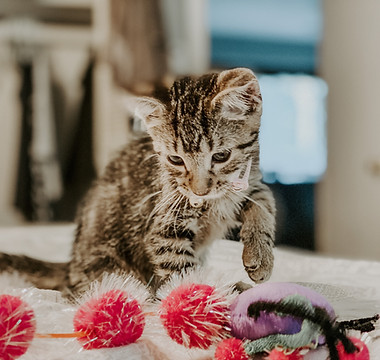

BREATHE EASY - IT'S ALL BENIGN
Most in office, needle breast biopsies come back as benign findings. Here are some of the most common benign findings that you may hear about when receiving a breast diagnosis - in alphabetical order below. Cats have nothing to do with anything, but we like them anyways.
An infection in the breast presenting as a painful eruption and typically treated with antibiotics.
Might present as pain, swelling, tenderness and redness, sometimes even an open sore.
Most resolve with antibiotics, sometimes aspiration or surgery will be needed for management.

A completely benign condition that occurs when the lobules in the breast become enlarged.
Due to that enlargement you might feel a lump or bump.
Sclerosing adenosis might need to be surgically removed as it is considered to be a higher risk lesion.

Cellulitis is a bacterial infection that can occur anywhere in the body if they skin has been broken.
You breast will be red and inflamed and might painful. You may also have a fever and chills.
This may occur post operatively or as a result of cancer treatments but it is benign and treatable if caught early. If it progresses it can lead to life threatening complications - so get it checked out.

A fluid collection in the breast that can become painful if it/they continue to enlarge.
Cysts are a normal and benign variant, they can fluctuate with hormonal changes.
For information on aspiration or drainage please see the procedure page for cyst aspiration by clicking HERE.

The benign condition in which the duct in the breast gets wider or thicker. It can lead you blockages and fluid collection. Blockages can be painful and once you know what it is you can try to reduce breast pain with heat and extra support.
This condition is more common in perimenopausal women.

Hyperplasia in the ducts represents and overgrowth of cells lining the ductal walls in your breast.
If this is a typical or normal(ish) variant then it is nothing to concern yourself with. If your ductal hyperplasia is classified as "atypical" then you will likely be recommended to have the area removed as it is considered to be a high risk benign lesion.
More about atypical ductal hyperplasia (ADH) HERE

An annoying bump that can actually appear anywhere on your body. They are non-cancerous and are so superficial that we can't even really say that they're in breast tissue when they show up in/on breasts.
They aren't all that common on the breast, despite being benign they can be obnoxious so you may want to opt to have a surgeon just cut it out.

Basically fat necrosis is a blob of fat that died - sexy...
Normally when your tissue is damaged by something traumatic you get a bump in that area and your body sections it off and it slowly dies.
Generally we see a new area of calcifications on mammography when this happens and we need further clarificiation.
Fat necrosis can occur post operatively, after a motor vehicle accident or if you dog jumps on you - don't stress about it though.

Fibroadenomas account for the most common breast lumps. We see them in patients of all ages, but most commonly they present as mobile lumps in pre-menopausal women.
They may be caused by our own hormones.
They tend to have a distinct shape on ultrasound and can be ruled out as cancer in most young people.
Unfortunately as we age they sometimes calcify and your doctor may want to ensure that everything is benign to be safe.

Is not actually a disease, but everyone calls it that.
Basically it means you have lumpy, bumpy breasts. They aren't going to harm you or increase your cancer risk, they can just be bothersome, sometimes even tender or painful.
Most fibrocystic changes in the breast are normal, but doctors would rather check you out when you report a problem just to ensure that you and you breasts are healthy.

Fibrosis is similar to fibrocystic thus the similarity in names.
Fibrous tissue is responsible for fibrosis. These areas may feel firm or even rubbery; sometimes they form a knot like lump and then you get a biopsy to make sure that it's not cancer.
Fibrosis is more common in women in childbearing ages and may be linked to hormonal activity and fluctuation.

A milk cyst.
These tend to how up in expectant, nursing mothers or women who recently stopped breastfeeding. They present as a small firm mass, normally behind the nipple.
Just some milk that didn't make it out. If it is aspirated the fluid removed will be milky in color rather than yellow, clear or blood tinged.

For the men out there - the benign growth of breast tissue.
Do you smoke marijuana? Take steroids? These are potential reasons to that men sometimes end up with this condition.
Normally imaging is enough to determine this condition. So if you're a man who is new to having breasts - you may need a mammogram (bilateral, diagnostic and an ultrasound), prepare yourself.

Hematomas are a collection of blood outside of the vessel, normally caused by injury to the blood vessel.
This can occur after any trauma, including biopsy, surgery, cyst aspiration, etc.
Your body is generally fully capable of resolving hematomas by itself, though it may take what feels like an eternity. If your hematoma is hot to the touch or feels like it is getting bigger, seek medical attention.

Benign fatty tumor composed of nothing more than adipose tissue. We know, breasts are generally fatty enough!
You can get lipomas anywhere on your body but finding a new lump on your breast is concerning. Most of the time imaging can determine your lump is a lipoma. If the area has changed in size or shape biopsy may be recommended.
If this is too much to deal with, go to see a plastic surgeon and have it removed.

Wart-like lumps inside your breast duct. Yep, it's not pleasant sounding.
Your doctor will probably recommend that you surgically remove the area. Papillomas can be lumped into that high risk benign category of papillary lesions so better safe than sorry.
You don't really want a wart in your boob, right?

Pseudoangiomatous stromal hyperplasia... can you pronounce it? PASH is easier to say and it is completely benign although the full on medical term seems imposing.
PASH can present as lump or bump and is more common in women of reproductive age, though sometimes it has been noted on the occasional male patient and some children.
It is simply an overgrowth of cells that you need to do nothing about.

A zit. A really deep zit.
Go see your dermatologist.

A fluid collection of serum under your skin's surface.
Seromas tend to develop post operatively and are a risk in all breast surgery procedures.
Some will resolve on their own, but others may need to be drained if they keep filling.

A very rare, unfortunately painful breast disorder involving abscesses and recurrent eruptions around the nipple area.
Commonly affecting younger women in childbearing age. Biopsy is necessary to rule out cancer and you may still need surgery to remove the problematic area.
Smoking is a risk factor and quitting is important to prevent recurrence.





